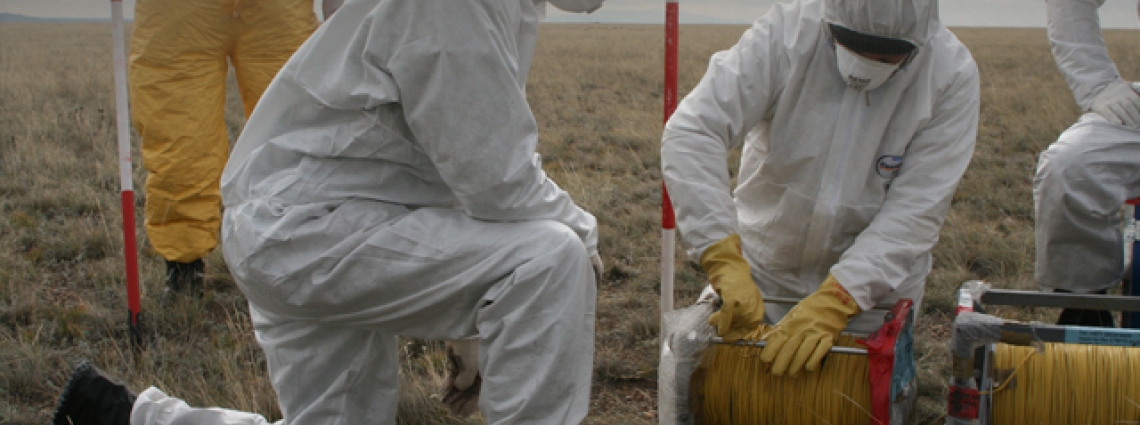Training the third generation of on-site inspectors
Have you got what it takes to brave the elements in all corners of the world to hunt down a fresh nuclear explosion, using the latest in science and technology?
An on-site inspection (OSI) is the final and most powerful verification measure under the Comprehensive Nuclear-Test-Ban Treaty (CTBT) to ascertain whether or not a nuclear explosion has taken place.
Real OSIs will only become possible after the CTBT’s entry into force. To prepare for this day, the Comprehensive Nuclear-Test-Ban Treaty Organization (CTBTO) is actively building the capacity of its future, or “surrogate” on-site inspectors.
An on-site inspection (OSI) is the final and most powerful verification measure under the Comprehensive Nuclear-Test-Ban Treaty (CTBT) to ascertain whether or not a nuclear explosion has taken place.
Real OSIs will only become possible after the CTBT’s entry into force. To prepare for this day, the Comprehensive Nuclear-Test-Ban Treaty Organization (CTBTO) is actively building the capacity of its future, or “surrogate” on-site inspectors.
An on-site inspection (OSI) is a meticulous search of a clearly defined inspection area to gather evidence on whether or not a nuclear explosion has taken place. The Comprehensive Nuclear-Test-Ban Treaty (CTBT) relies on OSI as the final verification measure to verify compliance, and will only happen once the CTBT has entered into force.
Contrary to the International Atomic Energy Agency (IAEA) and the Organisation for the Prohibition of Chemical Weapons (OPCW), the CTBTO does not employ a standing inspectorate, but relies on a roster of Member States experts available to participate in an OSI at short notice.
The CTBTO has so far trained more than 100 surrogate inspectors in the course of its first and second OSI training cycles and has now issued a call to its 183 Member States to nominate candidates for the third training cycle. A total of 50 candidates will be accepted.
The CTBTO has so far trained more than 100 surrogate inspectors in the course of its first and second OSI training cycles and has now issued a call to its 183 Member States to nominate candidates for the third training cycle. A total of 50 candidates will be accepted.
Recent OSI exercises and training activities include the Integrated Field Exercise IFE14 in Jordan in November 2014 and the Regional Introductory Course in Sri Lanka in November 2015.
The new inspectors will participate in a series of training courses, exercises and other activities starting in 2016 and lasting for approximately 3½ years. Those who complete the training cycle will be added to the roster of OSI surrogate inspectors.
Candidates should be experts in subjects related to OSI activities and techniques. These include position finding, visual observation, field radiation measurement, environmental sampling, passive seismological monitoring, resonance seismometry and active seismic surveys, or magnetic and gravitational field mapping.
As OSIs may be deployed in all climatic and terrain conditions, surrogate inspectors need to be ready and willing to perform in harsh environments and remote areas, have perfect command of English, cope with time pressure and work well as part of an international team.
As OSIs may be deployed in all climatic and terrain conditions, surrogate inspectors need to be ready and willing to perform in harsh environments and remote areas, have perfect command of English, cope with time pressure and work well as part of an international team.
How to become a “Surrogate” Inspector, video lecture by Ron Gavish, Chief of the Training Section, On-Site Inspection (OSI) Division
Nomination of candidates will need to be sent by Note Verbale from the Permanent Missions no later than 3 May 2016. Nominations should include written communication from the Permanent Mission of the State Signatory to the CTBTO confirming the support given to the candidate(s).
Related documents for applications:
- Note Verbale of 17 March 2016 (PDF)
- Announcement - Information and guidance for candidates (PDF)
- Expertise Table Third OSI Training Cycle (PDF)
31 Mar 2016
